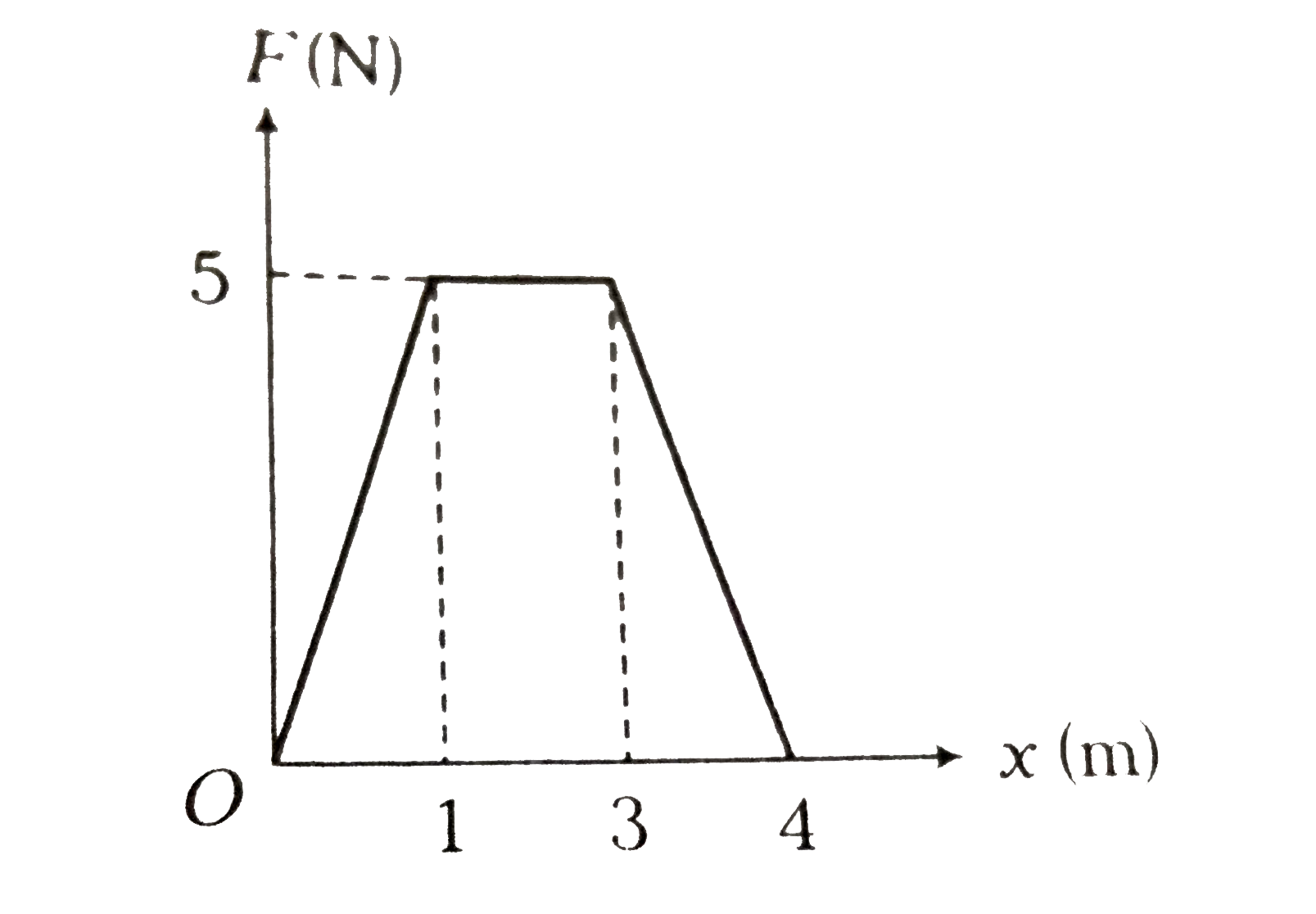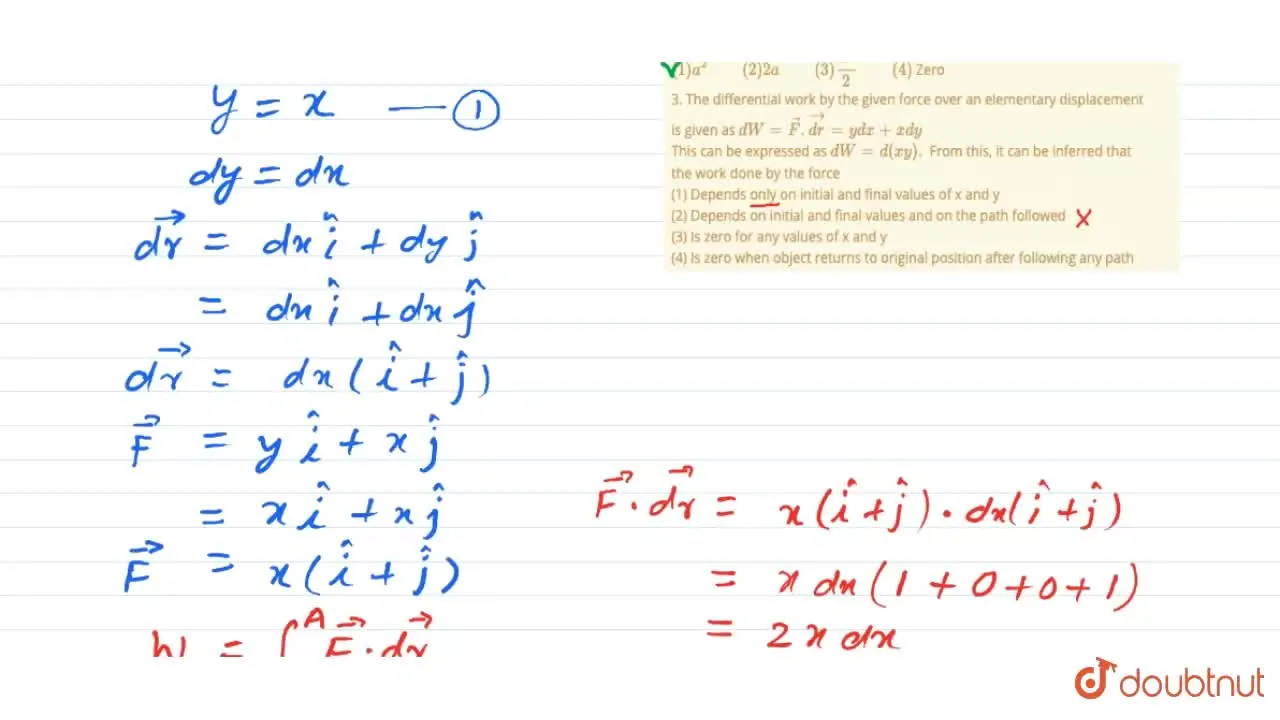A particle moves in x-y plane under action of a path dependent force F=yˆi+xˆj. The work done by the force as it moves in x-y plane can be evaluated by solving the integral ∫→F.→dr,where →dr=dxˆi+dyˆj. The position coordinates x and y will vary according to some constraint determined by teh path followed by the particle. For example, if particle moves along a straight line from one position to other, then an possible rarticle. For example, if particle moves along a straight line from one position to other, then a possible relation is y=mx+c. NOw. try to solve the following questions.
1. The particel moves along a straight line from origin to (a ,a) . The work done by the force on the particle is
(1)a2 (2)2s (3)a22 (4)Zero
2. The particle moves from (0,0) to (a,0) and then from, (a,0) to (a,a), in straight line paths. The work done by the force on the particle is
(1)a2 (2)2a (3)a22 (4) Zero
3. The differential work by the given force over an elementary displacement is given as dW=→F.→dr=ydx+xdy
This can be expressed as dW=d(xy). From this, it can be inferred that the work done by the force
(1) Depends only on initial and final values of x and y
(2) Depends on initial and final values and on the path followed
(3) Is zero for any values of x and y
(4) Is zero when object returns to original position after following any path
1. Answer (1) As the particle moves straight from (0,0) to (a,a) it moves along the line
y=ξmpliesdydx=1ordy=dx
Now, work done is calculated using
W=∫→F.→dr=∫(yˆi+xˆj)(dxˆi+dyˆj)
∫(ydx+xdy)
Taking y=xanddy=dx and limits from (0,0) to (a,a),
W=a∫02xdx=[x2]a0=a2
2. Answer (1)
The path followed is shown in the figure. For the path between (0,0) to (a,0), y remains constant
So, dy=0. Hence

W1=∫(ydx+xdy)=∫ydx
=y∫dx
=0a∫0dx=0
For the between (a,0) to (a,a) x remains constant and dx=0
⇒W2=∫(ydx+xdy)=x∫dy=aa∫0dy=a2⇒W=0+a2.
3. Answer (1,4)
dW=→F.→dr=ydx+xdy=d(xy)
⇒W=∫d(xy)=[xy](x2,y2)(x1y1)
=x2y2−x1y1
In this case, work depends only on (x1,y1) the initial position, and (x2,y2) the final position. If (x2,y2)=(x1,y1),W=0.
Related Playlists
- BOOK - AAKASH INSTITUTE ENGLISHCHAPTER - WORK, ENERGY AND POWEREXERCISE - IILUSTRATION2videos
WORK, ENERGY AND POWER
- BOOK - AAKASH INSTITUTE ENGLISHCHAPTER - WORK, ENERGY AND POWEREXERCISE - TRY YOURSELF95videos
WORK, ENERGY AND POWER
- BOOK - AAKASH INSTITUTE ENGLISHCHAPTER - WAVESEXERCISE - ASSIGNMENT ( SECTION-D ( Assertion - Reason Type Questions ))12videos
WAVES
Similar Questions
A particle moves along the straight line y=3x+5. Which coordinate changes at faster rate?
View SolutionA particle moves along x - axis under the action of a position dependent force F=(5x2−2x)N. Work done by force on the particle when it moves from origin to x = 3 m is
View SolutionThe force F acting on a particle is moving in a straight line as shown in figure. What is the work done by the force on the particle in the 4 m of the trajectory?
 View Solution
View SolutionA particle moves along the x-axis from x=0 to x=5m under the influence of a given by F=7−2x+3x2. The work done by the applied force to the particle is.
View SolutionA force f=10+2x acts on a particle moving in straight line on x axis the work done by this force during a displacement from x=0 and x=3m
View SolutionA particle moves in the x-y plane. It x and y coordinates vary with time t according to equations x=t2+2t and y=2t. Possible shape of path followed by the particle is
View SolutionA particle is moving with a constant speed along a straight line path. A force is not required to
View SolutionA force F is related to the position of a particle by the relation F=(10x2)N . Find the work done by the force when the particle moves from x=2m→x=4m.
View SolutionA force F=−k(^ˆi+xˆj) (where k is a positive constant) acts on a particle moving in the x−y plane. Starting from the origin, the particle is taken along the positive x-axis to the point (a,0) and then parallel to the y-axis to the point (a,a). The total work done by the force F on the particle is
(a) −2ka2 , (b) 2ka2,(c)-ka^(2),(d)ka^(2)View SolutionForce F on a particle moving in a straight line varies with distance d as shown in the figure. The work done on the particle during its displacement of 12m is
 View Solution
View Solution


